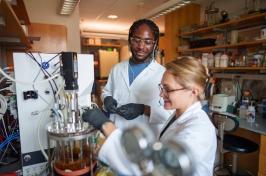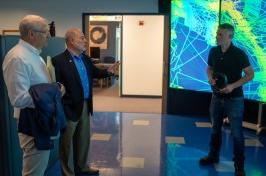
Could the household trick of hiding the cookie jar to promote better eating habits work on a larger scale at colleges and universities? A study by researchers from the University of New Hampshire suggests that this strategy might indeed be effective.
Loris Rubini and Deniz Ozabaci, associate professors of economics at UNH Peter T. Paul College of Business and Economics, found that the relocation of the dessert section at UNH’s Stillings Dining Hall to an area less visible to diners reduced cookie consumption by up to 18%.
This UNH research further complements research already published about the concept of “nudging,” the idea that simple “nudges” can accomplish a lot, including the effects of altering the location of food items, according to Rubini.
“Moving the food around can greatly affect consumption. For example, in supermarkets, placing gum near the cash register increased the consumption of gum a lot,” Rubini says. “We are showing that the opposite also works. Moving unhealthy food to remote places reduces its consumption.”
Stillings was UNH’s third dining hall until it closed in August 2021. Like the other dining halls on campus, diners at Stillings paid a fixed price for an “all you can eat” experience. The dessert section was initially located next to where students left their dishes when exiting the building. In spring 2018, the desserts were moved to the opposite end of the dining hall and were no longer in plain sight due to the introduction of a new hot food section.
To see if the move impacted dessert consumption, the professors built a model using data provided by dining hall staff. They compared the consumption of cookies and pizza from August 2017 to March 2019. Cookies were chosen because they were served daily as a dessert, while pizza was chosen as a comparison food because, like cookies, it’s unhealthy and offered every day, but unlike the cookies, pizza remained in the same location.
The data showed an 18% reduction in cookie consumption relative to pizza after the relocation, including an average drop of about 28 portions per day. The average drops in consumption were greater when focusing on narrower time frames: the drop is 48 portions when focusing on 30 days around the relocation, and 54 when focusing on 75 days. The drop in cookie consumption remained between 12% and 15% when the professors tested for uncontrollable variables.
Additionally, the data showed the drop was stronger on weekdays, while there was no significant effect on Sundays (Stillings was closed on Saturdays), and the decline in cookie consumption was more significant at lunchtime than at dinner. No significant drop in cookie consumption was found during finals, which the professors indicate in the study is consistent with previous research in the field about stress-induced eating during finals.
Rubini says he was expecting cookie consumption to drop, he just wasn’t sure by how much. He added that the study findings could give UNH, and other schools, something to consider.
“Moving the cookies out of sight is one policy that makes for healthier consumption,” he says. “It can go a long way in increasing healthy habits at very low costs.”
The study notes that 70% of students gain weight during their college years, about 12 pounds on average, while colleges participate in costly national nutrition programs that require strict compliance.
In addition to moving certain food items, the concept of nudging can be used to promote other healthy habits, such as exercise, according to Rubini.
Rubini said the professors wanted additional data for their research but faced several limitations, including limited availability of data before the move of the dessert section, no data on fruit consumption — to see if the drop in cookie consumption was replaced by an increase in fruit consumption — and no data from the other two UNH dining halls to control for changes in cookie consumption patterns.
The professors have submitted their research for potential publication.
-
Written By:
Aaron Sanborn | Peter T. Paul College of Business and Economics | aaron.sanborn@ngskmc-eis.net














































